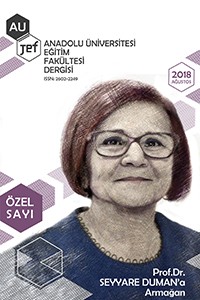Dilin Mizahta Kullanımı ve Uyuşmazlık Kavramı
Abstract
Mizahın doğasını anlamaya dönük gözlem, düşünce ve öneriler oldukça
eskilere uzanır ve bunlar genel olarak bilişsel,
toplumsal ve psikoanalitik yaklaşımlar
olmak üzere çok genel nitelikli üç başlık altında toplanır. Bu yaklaşımların
her biri mizah olgusuna farklı bir açıdan yaklaşır ve ilgili açıdan
belirginleşen özelliği öne çıkarak o özelliğin bir kuramını oluşturur. Mizaha
dair bir doğruluk ortaya koydukları tartışma götürmese de bu kuramların her birinin
mizahın yalnızca bir ya da birkaç yönünü anlamamızı sağladığı söylenebilir. Bu
yazı, mütevazi bir hedefe odaklanarak mizah barındıran metinleri biçimlendiren
temel özelliğin ‘uyuşmazlık’ olduğunu iddia eden bilişsel yaklaşımı mercek
altına almayı ve uyuşmazlık kuramlarının ilgili metinleri çözümleme biçimini
tartışmayı amaçlamaktadır.
Keywords
References
- Attardo, S. (1994). Linguistic Theories of Humour. Berlin: Mouton de Gruyter.
- Cebeci, O. (2016). Komik Edebi Türler: Parodi, Satir ve İroni. İstanbul: İthaki Yayınevi.
- Chomsky, N. (1965). Aspects of the Theory of Syntax. Cambridge, Massachusetts: MIT Yayınları.
- Chomsky, N. (1986). Knowledge of Language. Cambridge, Massachusetts: MIT Yayınları.
- Freud, S. (1966). Jokes and their relation to the unconscious. Londra: Routledge & Kegan Paul.
- Grice, H. P. (1975). Logic and conversation. Speech Acts içinde, (yay. haz.) Cole, P., and J.L. Morgan, 41–58. New York: Academic Yayıncılık.
- Hurley, M. M. ve diğeleri. (2011). Inside Jokes: Using Humor to Reverse-Engineer the Mind. Cambridge, Massachusetts: MIT Yayınları.
- Koestler, A. (1970). The Act of Creation. Londra: Pan Yayıncılık.
- Minsky, M. (1980). Jokes and the logic of the cognitive unconscious. AI Memo 603, MIT, Artificial Intelligence Laboratory, Cambridge, Massachusetts.
- Raskin, V. (1985). Semantic Mechanisms of Humour. Dordrecht: Reidel.
- Ritchie, G. (1999). Developing the Incongruity-Resolution Theory. AISB Symposium on Creative Language: Stories and Humour Bildirileri kitabı içinde, Edinburgh, April 1999, 78-85.
- Ritchie, G. (2000). Describing Verbally Expressed Humour. In Proceedings of AISB Symposium on Creative and Cultural Aspects and Applications of AI and Cognitive Science, 71-78. Birmingham.
- Rothbart, M. K. & Pien, D. (1977). Elephants and Marshmallows: A Theoretical Synthesis of Incongruity-resolution and Arousal Theories of Humour. Humour and Laughter: Theory, Research and Applications içinde, (yay. haz.) Anthony J. Chapman/Hugh C. Foot, 37– 40, London.
- Shultz, T. R. (1974). Development of the appreciation of riddles. Child Development, 45:100–105.
- Shultz, T. R. (1976). A Cognitive-Developmental Analysis of Humour. Humour and Laughter: Theory, Research and Applications içinde, (yay. haz.) Anthony J. Chapman/Hugh C. Foot, 11 – 36. London.
- Suls, J.M. (1972). A two-stage model for the appreciation of jokes and cartoons: an information-processing analysis. In Jeffrey H. Goldstein/Paul E.McGhee (eds.), The Psychology of Humor, 81-100, New York.
Use of Language in Humor and The Concept of Incongruence
Abstract
Observations, ideas, and proposals that aim to have an insight into
humor date back to ancient times, and those proposals that have been generally
accepted in this particular field of study are commonly classified into three
groups as cognitive, social, and psychoanalytical approaches. Each one of these
approaches focuses on a different aspect of humor, and builds a theory around
this particular aspect. It is fair to say that each one of these theories built
this way explains one aspect of the truth about humor yet none of them provides
an across-the-broard theory of humor in its extended sense. This paper aims to
investigate into the nature of humor by focusing in on the concept of
‘incongruence’ / ‘conflict’ as understood within cognitive models and to discuss
the ways that incongruence models analyze texts that contain verbally expressed
humor.
Keywords
References
- Attardo, S. (1994). Linguistic Theories of Humour. Berlin: Mouton de Gruyter.
- Cebeci, O. (2016). Komik Edebi Türler: Parodi, Satir ve İroni. İstanbul: İthaki Yayınevi.
- Chomsky, N. (1965). Aspects of the Theory of Syntax. Cambridge, Massachusetts: MIT Yayınları.
- Chomsky, N. (1986). Knowledge of Language. Cambridge, Massachusetts: MIT Yayınları.
- Freud, S. (1966). Jokes and their relation to the unconscious. Londra: Routledge & Kegan Paul.
- Grice, H. P. (1975). Logic and conversation. Speech Acts içinde, (yay. haz.) Cole, P., and J.L. Morgan, 41–58. New York: Academic Yayıncılık.
- Hurley, M. M. ve diğeleri. (2011). Inside Jokes: Using Humor to Reverse-Engineer the Mind. Cambridge, Massachusetts: MIT Yayınları.
- Koestler, A. (1970). The Act of Creation. Londra: Pan Yayıncılık.
- Minsky, M. (1980). Jokes and the logic of the cognitive unconscious. AI Memo 603, MIT, Artificial Intelligence Laboratory, Cambridge, Massachusetts.
- Raskin, V. (1985). Semantic Mechanisms of Humour. Dordrecht: Reidel.
- Ritchie, G. (1999). Developing the Incongruity-Resolution Theory. AISB Symposium on Creative Language: Stories and Humour Bildirileri kitabı içinde, Edinburgh, April 1999, 78-85.
- Ritchie, G. (2000). Describing Verbally Expressed Humour. In Proceedings of AISB Symposium on Creative and Cultural Aspects and Applications of AI and Cognitive Science, 71-78. Birmingham.
- Rothbart, M. K. & Pien, D. (1977). Elephants and Marshmallows: A Theoretical Synthesis of Incongruity-resolution and Arousal Theories of Humour. Humour and Laughter: Theory, Research and Applications içinde, (yay. haz.) Anthony J. Chapman/Hugh C. Foot, 37– 40, London.
- Shultz, T. R. (1974). Development of the appreciation of riddles. Child Development, 45:100–105.
- Shultz, T. R. (1976). A Cognitive-Developmental Analysis of Humour. Humour and Laughter: Theory, Research and Applications içinde, (yay. haz.) Anthony J. Chapman/Hugh C. Foot, 11 – 36. London.
- Suls, J.M. (1972). A two-stage model for the appreciation of jokes and cartoons: an information-processing analysis. In Jeffrey H. Goldstein/Paul E.McGhee (eds.), The Psychology of Humor, 81-100, New York.
Details
| Primary Language | Turkish |
|---|---|
| Subjects | Studies on Education |
| Journal Section | Research Article |
| Authors | |
| Publication Date | August 31, 2018 |
| Published in Issue | Year 2018 Volume: 2 - Prof. Dr. Seyyare DUMAN (Special Issue) |
Anadolu University Journal of Education Faculty (AUJEF)
Phone: +902223350580-3550 E-mail: aujef@anadolu.edu.tr
Website: https://aujef.anadolu.edu.tr/

This work is licensed under a "Creative Commons Attribution-NonCommercial-ShareAlike 4.0 International License" from 2020.

